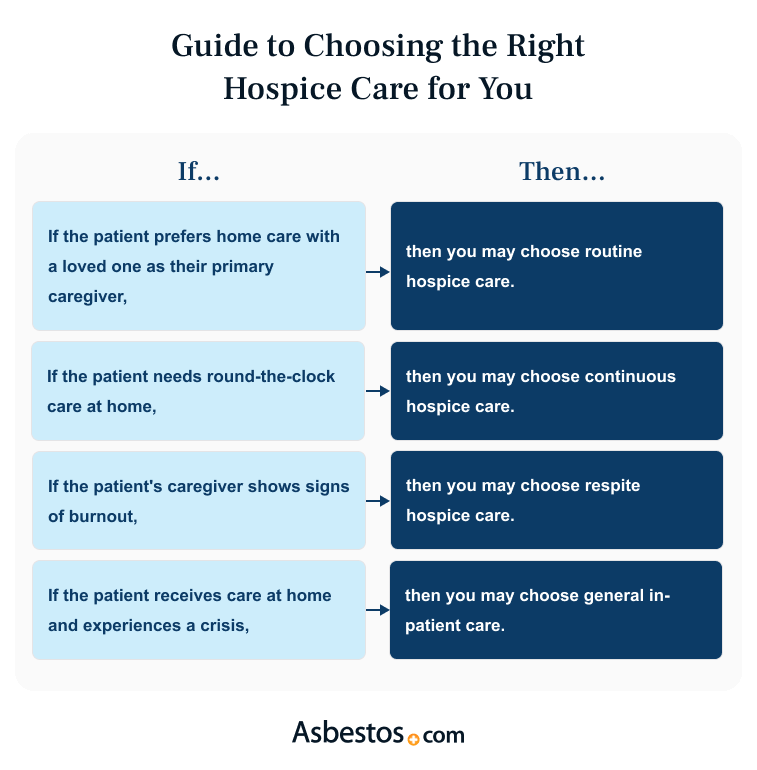Rich and Aline DeLisle made the difficult decision recently to stop Rich’s pleural mesothelioma treatment and begin home hospice care. Then, something unusual happened. The party started. Sons and daughters, in-laws, grandchildren and great grandchildren, nieces and nephews, and friends he hadn’t seen in years, all began descending upon their Central Florida home.
Four Levels of Hospice Care for Mesothelioma Patients
Mesothelioma patients need specialized attention during the disease’s later stages. Four levels of hospice care address these needs: Routine home care, general inpatient care, continuous home care and respite care. Understanding the services in each level helps you decide the right type for you.
Understanding the Four Levels of Hospice Care
The 4 different types of hospice care pinpoint the level and kinds of care needed, the stage of the disease and the patient’s location. Hospice providers supplement what primary physicians, family members or other caregivers do, promoting quality of life, offering comfort and addressing various needs.
Malignant mesothelioma is an aggressive form of cancer that typically spreads throughout the body, drastically shortening life expectancy. Hospice care for mesothelioma patients also supports their caregivers during the patient’s end-stages of life.
- Routine home care
- General inpatient care
- Continuous home care
- Respite care
Hospices must provide all 4 levels of care to qualify for Medicare certification. Private insurance companies may have their own hospice provider eligibility requirements.
Private insurers and Medicare cover most hospice-related expenses, but check the patient’s policy specifics to see if there are any coverage exceptions. For example, Medicare only pays for room and board in certain situations.
Hospice Care vs. Palliative Care
While both palliative and hospice care help patients with serious illnesses live more comfortably, each has specific goals and parameters. Hospice care is more focused on end-of-life situations while palliative care also happens along with treatment.
Palliative care initiated soon after a mesothelioma diagnosis can help patients fare better as the disease progresses, potentially prolonging life. Hospice care typically begins when life expectancy reaches 6 months, focusing on comfort rather than curative treatments. Patients who choose to discontinue curative treatments may also qualify for hospice care.
| Mesothelioma Palliative Care | Mesothelioma Hospice Care | |
|---|---|---|
| Coverage | Private or commercial health care plans | Available to everyone through Medicare, Medicaid and private insurers |
| Goal | Manage symptoms and pain; may include curative intent; educating patients and families about mesothelioma | Promote quality of life, patient comfort and support for patients and their families |
| Location | Hospitals and cancer centers, assisted living facilities or the patient’s home | The patient’s home, dedicated hospice facilities and assisted living or nursing home facilities |
| Timing | At any stage after diagnosis | Life expectancy under 6 months |
| Process | Receive curative treatments along with palliative care | No longer undergo curative treatment, hospice care teams manage symptoms |
Palliative treatment for mesothelioma patients focuses on a patient’s needs rather than their prognosis. It may include managing symptoms such as appetite loss and pain. Patients may receive palliative care alongside cancer treatments. Palliative care medical professionals coordinate with the patient’s mesothelioma doctors.
While hospice care shares similarities with palliative care such as pain and symptom relief and comfort care, there are significant differences. Hospice care typically only begins when the patient’s medical team, the patient and their family agree that further curative treatments should end. Treatments in hospice care don’t have a curative intent.
Routine Home Care
With routine home care, the most common of the 4 levels of hospice care, hospice teams travel to where the patient lives to administer care. In this stage, patient symptoms, including breathing difficulties, nausea and vomiting, are typically under control and the patient’s condition is stable.
Most people, including patients with terminal illnesses like mesothelioma, are more comfortable at home. If the spread of mesothelioma progresses, it can make providing physical care at home more challenging for family members. As home care becomes more difficult, families often partner with a hospice team for additional support.
As we began home hospice care, we invited everyone to come now and see him. It’s been wonderful. He hasn’t smiled and laughed this much in quite a while.
Routine home care allows mesothelioma patients to stay in a comfortable space while still receiving the specialized care they need. Homemaker services and hospice aids are options for routine home care patients. Hospice teams visit the patient but don’t provide around-the-clock assistance with this stage of hospice.
The Mesothelioma Center and various organizations offer support for mesothelioma patients and their families, starting with this first level of care. This support includes support groups, financial support and lodging close to care facilities. Patient Advocates can assist mesothelioma survivors and their loved ones throughout their journeys from diagnosis to different levels of hospice care.
General Inpatient Care
During the general inpatient stage of hospice care, hospice teams care for patients in tandem with the facility’s staff. Mesothelioma patients often face short-term health crises beyond the scope of what home hospice care provides.
Brief inpatient stays can become necessary when acute or chronic symptoms flare up or pain is unmanageable at home. Patients need qualified medical professionals nearby 24/7 during these times to provide fast interventions.
Being brave enough to be open to accept help from all the members of the hospice care team can be very helpful at reducing emotional distress.
Heightened stress often accompanies mesothelioma crises, for both patients and their families. The continuity of seeing the familiar faces of hospice workers in unfamiliar surroundings often comforts patients.
Some people are reluctant to show self-perceived weakness in front of loved ones. It’s sometimes easier for patients and families to open up about fears and feelings to compassionate, caring relative strangers in the form of hospice team members.
Get Your Free Mesothelioma Guide

Find a Top Mesothelioma Doctor

Access Help Paying for Treatment

Continuous Home Care
During crises that don’t require hospitalization, mesothelioma hospice patients can benefit from nursing care in their homes through continuous home care. Health care professionals remain in the home for at least 8 hours and sometimes stay around the clock.
This stage of hospice care is typically brief, only lasting until the crisis is over. The primary focus is managing acute symptoms to make patients more comfortable.
Continuous home care has multiple benefits for mesothelioma patients and their families. Hospice workers taking over physical care restores some opportunities for patients and their loved ones to focus on interacting as a family.
Hospice caregivers can help patients and families understand what to expect as mesothelioma progresses. This level of care offers the expertise of trained professionals during symptomatic episodes.
Respite Care
Respite care helps to minimize the risk of caregiver burnout. This stage of hospice care allows primary caregivers to take a break for short periods while professionals take care of the patient.
Caring for someone with mesothelioma has an impact on caregivers’ mental, emotional and physical health. Caregivers may have trouble sleeping, maintaining a healthy diet or even getting fresh air or exercise. They may feel frustrated, irritable or angry.
These effects can be particularly challenging to balance with outside employment, children at home and other obligations. In a 2023 study of caregivers’ experiences, employed caregivers reported experiencing mean activity impairment of 40%, indicating caregiving had a direct impact on their work life.
Most mesothelioma patients don’t like being the cause of caregiver stress, welcoming the opportunity for their caregiver to have some much-needed downtime. Patients may also appreciate getting to interact with new people.
How To Determine the Right Level of Mesothelioma Hospice Care
When you decide that it’s time for hospice care, there are several factors to consider when determining which level of care is appropriate. Your hospice provider can help you make the right choice.

Your goal is to make the patient more comfortable and offer support for the primary caregiver as well. Asking for help can be difficult for many people, but selecting the right hospice services for you can make a positive difference.
Recommended Reading





